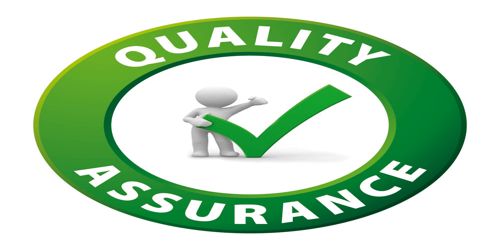Quality Assurance
In developing products and services, quality assurance is any systematic process of checking to see whether a product or service being developed is meeting specified requirements. Many companies have a separate department devoted to quality assurance. It is the process of verifying whether a product meets required specifications and customer expectations. QA is a process-driven approach that facilitates and defines goals regarding product design, development and production.
A quality assurance system is said to increase customer confidence and a company’s credibility, to improve work processes and efficiency, and to enable a company to better compete with others. Quality assurance was initially introduced in World War II when munitions were inspected and tested for defects after they were made. Today’s quality assurance systems emphasize catching defects before they get into the final product.
Purposes of Quality Assurance
By ensuring a level of quality in its products or services, the business is able to build a positive reputation for reliability and consistency. This bolsters consumer trust and confidence in the business and helps it compete with other businesses in the same market.

What is quality:
Quality can be defined as the totality of features and characteristics of a product or service that bears on its ability to satisfy given needs. Another way “quality measures how well a product or service meets customer needs, he basic consideration is thus always the extent to which the product or service meets the customer’s expectation. Besides above this, there are several definitions of quality or quality dimensions. According to David Garvin it may be either:
- Transcendent: Quality is something that is intuitively understood but nearly impossible to communicate. Like beauty or love.
- Product Based: Quality is the features and attributes of a product
- User Based: If the customer is happy then it is of good quality.
- Manufacturing Based: If the product conforms to the design Specifications then it have a good quality.
- Value Based: If the product is perceived as providing good value for the price, it is quality product.
So it shows that quality is a dynamic state and changes continually as it goes to different customer .it gives rise the two types of customer: Internal and external customer. Anyway since customer is the use; of a product, they are the ultimate judge of the quality. Hence quality involves meeting customer need and exceeding customer expectation.
To satisfy a customer we need quality product. And a product is again a result of people, process, service and environment. Therefore management of product, people, process, service and environment to meet and exceed customer expectation gives rise to Total Quality Management.
Quality Assurance Tools & Techniques
There are many tools and techniques that form the basis of the key quality assurance principles. Some of these include…
- Cost-Benefit Analysis
- Cost of Quality (COQ)
- Control Charts
- Benchmarking
- Design of Experiments (DOE)
- Statistical Sampling
- Flow Charting
- Quality Management Methodologies (i.e. Six Sigma, CMMI, etc)
- Cause and Effect Diagrams (i.e. Fishbone Diagram)
- Histogram
- Pareto Chart
- Run Chart
- Scatter Diagram
- Inspection
Various methodologies may be used to improve QA, including:
- Total Quality Management (TQM): If a product does not adhere to quality standards, the product’s quality cannot be guaranteed.
- Failure Testing: A product is tested until the product fails. The product may be subject to high temperatures or vibrations in an effort to trigger unanticipated errors.
- Statistical Control: This brings an organization to a Six Sigma quality level.
International Quality Assurance Standards
In 1947, an international federation of organizations known as ISO was founded. The International Organization for Standardization is made up of standards organizations that represent over 100 countries and maintains effective quality assurance system for manufacturing and service industries.
ISO 9000 is a set of standards first published in 1987 designed to help organizations meet statutory and regulatory requirements, as well as consumer needs, for product quality. Manufacturers and businesses can become certified by fulfilling the requirements defined in ISO 9001. This offers independent confirmation of an organization’s adherence to quality standards, and more than one million organizations around the world are certified with ISO 9001.
Information Source:
















